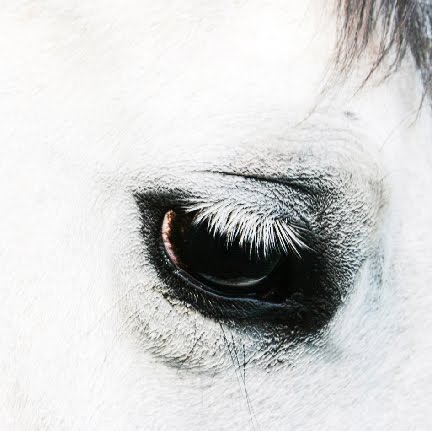Third-Eyelid Tumors in Horses: Schedule a Yearly Eye Exam with Your Veterinarian
- March 10, 2017
- ⎯ Fran Jurga
by Fran Jurga | 2 November 2009 | The Jurga Report at Equisearch.com
Early intervention is the best way to beat cancerous conditions of the third eyelid in horses. Look periodically for any lumps or broken skin in or around your horse’s eyes, and call a veterinarian if you find anything. If treated early, they may be fully removed; if left too long, recurrence is common. The condition is especially common in horses with light coat colors.

Squamous cell carcinoma, also abbreviated as SCC, is one of the most common cancers in horses. Appearing as small, wart-like bumps commonly found on the eyelid or surface of the eye, they require early treatment. While a conscientious owner may quickly notice a new lump on the shoulder of his or her equine friend, even the most watchful horseperson will miss a concealed third eyelid tumor.
The nictitating membrane, or third eyelid, is a very interesting anatomical component of most mammals’ and birds’ eyes. It is a white to pinkish membrane that usually remains in hiding in the corner of the eye until debris or trauma is detected, in which case it swiftly slides across the eyeball in a horizontal motion. Interestingly, humans do not have a third eyelid, but we do have a remnant called the plica semilunaris. It is visible in the corner of your eye as a small white membrane where “sleep” or eye discharge can accumulate.
But in contrast to humans, horses have a substantial nictitating membrane. The trouble is most horse owners don’t know to look at it because they never see it. “Squamous cell carcinoma of the third eyelid can be a very easy lesion to miss,” says Dr. Amber Labelle, an ophthalmology resident at the University of Illinois Veterinary Teaching Hospital in Urbana. It’s one of the many reasons why horses should have a thorough eye exam once a year, often when they receive their annual vaccines.
Just like certain skin tumors in humans, SCC is linked to UV radiation from the sun. Dr. Labelle mentions that, “It is especially common in horses with less pigment in their eyes, like Paints, Appaloosas, and some draft breeds.” SCC is also commonly found in the genital region of older male horses with light skin. In short, the less pigment a horse has in a certain area, the more cancer-causing UV radiation it can absorb.
Although there are some tumors that spread quickly, SCC is a more slow-growing kind that doesn’t seem to metastasize until a much later stage. Nevertheless, “early detection is the key to early cure,” notes Dr. Labelle. The sooner veterinarians can surgically remove the tumor with wide margins, and potentially use local radiation treatments, the better the prognosis.
The problem that is unfortunately much too common is that horse owners either miss or put off having a vet check out that lump on their horse’s eye. And by the time the tumor is diagnosed, it has grown so large that adequate margins cannot be taken. In short, an enucleation (total removal of the eye) may need to be performed to stop the tumor from spreading.
What’s even more of a heartbreaking situation is that horses that have had a SCC removed need to have a recheck appointment every 6 months. It is common that these tumors grow back. Just because it’s been removed once, doesn’t mean it can’t come back with a vengeance and potentially spread to other parts of the body, which can be fatal.
If you are concerned about any new growth on your horse, Dr. Labelle advises owners that, “any pink lump or bump or ulcerated lesion in or around the eye needs a veterinarian’s attention.”
Thanks to UMass Extension for bringing this article to our attention through the xtension.org web site and to Dr Labelle and writer Ashley Mitek of the University of Illinois College of Veterinary Medicine for providing this information.








